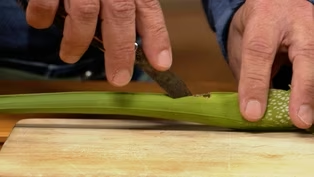Virginia Home Grown
Poisonous Plants
Clip: Season 25 Episode 8 | 7m 30sVideo has Closed Captions
Learn how to identify poisonous plants
Shaheen Alikhan visits the studio to talk about dangerous plants and explain that while some of them are poisonous to humans they may benefit pollinators or have therapeutic or historical value. Featured on VHG episode 2508, October 2025.
Problems playing video? | Closed Captioning Feedback
Problems playing video? | Closed Captioning Feedback
Virginia Home Grown is a local public television program presented by VPM
Virginia Home Grown
Poisonous Plants
Clip: Season 25 Episode 8 | 7m 30sVideo has Closed Captions
Shaheen Alikhan visits the studio to talk about dangerous plants and explain that while some of them are poisonous to humans they may benefit pollinators or have therapeutic or historical value. Featured on VHG episode 2508, October 2025.
Problems playing video? | Closed Captioning Feedback
How to Watch Virginia Home Grown
Virginia Home Grown is available to stream on pbs.org and the free PBS App, available on iPhone, Apple TV, Android TV, Android smartphones, Amazon Fire TV, Amazon Fire Tablet, Roku, Samsung Smart TV, and Vizio.
Providing Support for PBS.org
Learn Moreabout PBS online sponsorshipSo, Shaheen, this is a topic we rarely talk about, but it's one we need to raise awareness of.
>>Yes.
So, I would like to add that all of these plants here are dangerous, some of them more so than others.
And as a reminder to everyone, please don't endanger yourself or anyone else around you, pets or people.
>>Mm-hmm.
>>And I'd like to start with some very common basic spring bulbs >>Yes.
>>That a lot of people grow.
Many of these are plants that we grow either in our gardens or that are around us, just in the wild and people aren't aware.
But we have crocuses and snowdrops, tulips, and daffodils that most of us are accustomed to.
And most people are aware that they do have some toxins, but not how toxic they are, >>Yes.
>>particularly things like the snowdrops here.
>>Yes, yes.
>>And so, moving from some of those, we're gonna be getting into some other toxic plants.
Some of my favorites are in the nightshade family.
>>Mm-hmm.
>>So, we're gonna start with the Brugmansia here, angel's trumpet, which of course, is not in bloom at the moment, >>Right.
>>But has very, very dramatic flowers.
And one of the most dangerous parts of it is actually the scent, because you don't typically think of that >>Mm-hmm.
>>as being something that can endanger you.
>>Yes.
>>People think just ingesting it is the danger.
>>Right.
Particularly for children coming up and smelling this beautiful hanging >>Exactly.
>>trumpet type flower.
>>Exactly.
They smell very sweet.
They're incredibly beautiful.
They're very tempting for people to come up >>Mm-hmm.
>>and smell.
And so, I would just say don't.
>>Yes.
(Shaheen chuckles) >>Just let it waft towards you.
>>Yes.
>>And from- >>That nightshade >>That >>to other nightshades.
>>nightshade to several others here, >>Mm-hmm.
>>these are some of the common ones that we get in Virginia.
We have Buffalo bur, Buffalo bur right here.
We have horsenettle right here.
>>Mm-hmm.
>>And my favorite, bittersweet nightshade right here.
>>Which we have to excuse, it is October.
>>Exactly.
But we still have one berry left on one of the plants.
>>Mm-hmm.
>>And all of these have, most of them have a strong history, either of witchcraft or medicinal use or ancient Greek mythological attributes.
>>Right.
And we have to understand too, these plants develop these attributes to protect themselves.
>>Mm-hmm.
>>It wasn't just, oh gee, I'm going to make this compound.
>>Right, right.
>>But it's really, it's a protection for them to survive in the ecosystem.
>>Mm-hmm.
Anything that's, I think, that's biologically expensive for them, >>Yeah.
>>there has to be a reason for it, right?
>>Yes.
Mm-hmm.
>>And so, we're gonna move on to aconite right here, our monkshood- >>Which is one of the reasons for the gloves.
>>Which is one of the reasons for the gloves.
>>Yes.
>>Several of them are transdermal to some degree.
This is one of the ones that's more severely transdermal.
>>Mm-hmm.
>>So, we just wanna be sure, >>Yes.
>>just in case we brush against it or just picking it up.
This was when I preserved with some glycerin because I wasn't sure if it would still be >>Yeah.
>>okay right now It turns out it was.
>>Mm-hmm.
>>But this one was used in the ancient world as an arrow poison, hence the Wolfsbane, and the monkshood >>Mm-hmm.
>>because of the shape of the flower.
>>Right.
But this is a plant to grow, but toward the back of the border.
>>I'll put it right there again.
>>Yeah.
>>Yes.
And it's- >>Absolutely toward the back of the border.
>>It's a beautiful one.
It's tall and you don't wanna put it somewhere that you can easily brush against it >>Exactly.
>>or along a walkway.
>>Mm-hmm.
>>And because it's tall, it's easier to do that.
>>Exactly.
>>So, another one that's very common is oleander.
>>And yep, this is not hardy in our zone.
>>No, it is not.
Even though it's listed as hardy, it apparently can die all the way back, as you have had.
>>Mm-hmm.
>>And I've been afraid I've brought it in every winter.
So, this is one that is more common in warmer zones.
You'll see >>Mm-hmm.
>>really kind of extensive trees of it.
>>Yes.
>>And it's beautiful.
It comes in a lot of colors.
It is incredibly toxic.
>>Yes.
>>I wouldn't suggest burning and smelling any of these, but this is particularly toxic >>Yes.
>>when it's burned.
The smoke from it when inhaled is really not good for you.
>>Right.
>>And so, we are going to move on to- >>But a more common plant that we don't even think about and this is a seedling of it.
>>A very, very common one.
>>Yeah.
>>This was a volunteer from my favorite black hellebore.
>>Yeah.
>>So, also sometimes called Lenten rose or Christmas rose.
>>Mm-hmm.
>>And these are a very, very popular, very fun, often even at elementary schools.
>>Yes.
>>Like they're grown extensively as landscape plants.
This is in the Ranunculus family, so it's related to buttercups.
>>Mm-hmm.
>>And this was also one of the ones that had some associations with witchcraft, with the flying ointment.
>>Mm-hmm.
Yes.
>>And it blooms in the winter.
So, it's also a very fun winter garden plant, >>Right.
>>which is how I started >>Right.
>>with these.
>>But we don't wanna eat it.
>>No, absolutely not.
>>Nor do we wanna eat these.
>>No, we don't wanna eat these either.
Although pokeweed or ink weed, it's a very, very common plant in Virginia.
And there are parts of it that are conditionally edible.
So, the young leaves, if they're boiled in several changes of water, >>Oh my gracious.
Yes.
>>but I would not recommend doing that.
>>Would never recommend that.
Yes.
>>And so, it has also been referred to as sort of like poor men's food, >>Mm-hmm.
>>the poor man's staple, food.
>>But please don't.
>>But please don't.
(Peggy laughing) Again, disclaimer.
>>Yeah.
>>And you would have to think, people would have to be in pretty dire straits in order to try that.
>>Yeah.
>>And we don't have time to squish it.
It's also used as an ink.
>>Well, we've got one minute left.
So, I wanted to go through a few of these.
>>Okay.
So, we'll definitely get to the snakeroot right here.
>>Yes.
>>And so, this one is often can be mistaken or the other way around, it's a lookalike with the Eupatorium with the bonesets.
>>Right.
>>But this one is, it can cause milk sickness.
And so, because some of the effects take quite some time, >>Mm-hmm.
>>animals, especially when there's not a lot of other forage, they can browse on this and they can pass on the toxins in their milk either to their young or to humans.
And so, this was apparently allegedly the plant that was responsible for the death of Abe Lincoln's mother.
>>Oh, I'm so sorry.
>>So, that was a very common sort of settler issue, was milk sickness.
And it was because >>Yeah.
>>of this particular plant.
But it's very valuable for pollinators.
>>Right, plus it blooms so late in dry shade.
>>Yeah, yeah.
>>And that's a particular one.
>>Yeah.
>>We got seconds left.
So, who do you wanna talk >>Okay.
>>about last?
>>So, we'll talk about some of the ones that are dangerous to touch.
>>Right.
>>So, we've got our black locust and we've got our Virginia creeper, and then some spurge.
>>Yes.
>>And the spurge, that sap can actually make you go blind.
>>Yes.
Please don't touch your hands.
>>So, please don't touch that.
The Virginia creeper, some people are fine >>Some people, mm-hmm.
>>and some people react almost the way they would to poison ivy.
>>Right.
>>And the black locust, it's not just gently brushing against it, it's usually the inner bark or some of the other parts of it.
>>The seeds and the leaves, yes.
>>Can be very damaging.
And that can also cause neurological damage.
>>Yes.
>>But the flowers are edible.
>>Yes.
>>So, you have to be very careful.
Some of them have, or they can be used medicinally.
>>Yeah.
You have properties that you have to be aware of.
So, do your homework.
>>Absolutely.
Absolutely.
>>Yes.
>>Do your homework, please.
Yes, they're fun, but don't think, "Oh, I'm just gonna go grow some of these."
Because you also have to be very careful even just weeding around them in the garden, planting them, just moving around them.
>>Yes.
Well, Shaheen, thank you for opening our eyes up to see what is in our gardens with a new perspective.
>>Well, thank you.
>>Yes.
Video has Closed Captions
Clip: S25 Ep8 | 26m 46s | Explore the world of deadly plants to discover their benefits! (26m 46s)
Video has Closed Captions
Clip: S25 Ep8 | 8m 5s | Discover Virginia’s native carnivorous plant! (8m 5s)
Plants that can be Toxic to Pets
Video has Closed Captions
Clip: S25 Ep8 | 7m 36s | Learn about common and uncommon plants with toxic properties (7m 36s)
Video has Closed Captions
Clip: S25 Ep8 | 3m 31s | Learn how to grow Venus flytraps at home (3m 31s)
What is inside a pitcher plant?
Video has Closed Captions
Clip: S25 Ep8 | 5m 56s | Discover how many insects pitcher plants catch. (5m 56s)
When Tomatoes were Considered Poisonous
Video has Closed Captions
Clip: S25 Ep8 | 2m 44s | Discover why tomatoes did not catch on in Europe for hundreds of years (2m 44s)
Providing Support for PBS.org
Learn Moreabout PBS online sponsorship

- Home and How To

Hit the road in a classic car for a tour through Great Britain with two antiques experts.












Support for PBS provided by:
Virginia Home Grown is a local public television program presented by VPM






